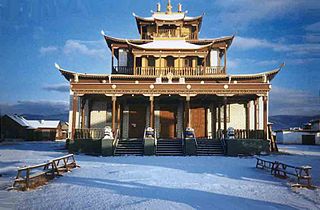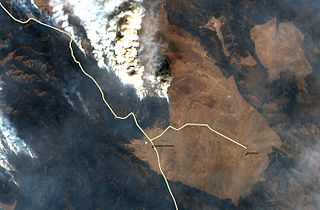
Amur Oblast is a federal subject of Russia, located on the banks of the Amur and Zeya rivers in the Russian Far East. The oblast borders Heilongjiang province of the People's Republic of China (PRC) to the south.

The Russian Far East is a region in North Asia. It is the easternmost part of Russia and the Asian continent, and is coextensive with the Far Eastern Federal District, which encompasses the area between Lake Baikal and the Pacific Ocean. The area's largest city is Khabarovsk, followed by Vladivostok. The region shares land borders with the countries of Mongolia, China, and North Korea to its south, as well as maritime boundaries with Japan to its southeast, and with the United States along the Bering Strait to its northeast.

The Far Eastern Republic, sometimes called the Chita Republic, was a nominally independent state that existed from April 1920 to November 1922 in the easternmost part of the Russian Far East. Although nominally independent, it largely came under the control of the Russian Soviet Federative Socialist Republic (RSFSR), which envisaged it as a buffer state between the RSFSR and the territories occupied by Japan during the Russian Civil War of 1917–1922. Its first president was Alexander Krasnoshchyokov.

Nerchinsk is a town and the administrative center of Nerchinsky District in Zabaykalsky Krai, Russia, located on the left bank of the Nercha River, 7 kilometers (4.3 mi) above its confluence with the Shilka River, 644 kilometers (400 mi) east of Lake Baikal, about 225 kilometers (140 mi) west of the Chinese border, and 305 kilometers (190 mi) east of Chita, the administrative center of the krai. Population: 14,959 (2010 Census); 15,748 (2002 Census); 16,961 (1989 Soviet census); 6,713 (1897).

Zabaykalsky Krai is a federal subject of Russia, located in the Russian Far East. Its administrative center is Chita. As of the 2010 Census, the population was 1,107,107.

Climate change has serious effects on Russia's climate, including average temperatures and precipitation, as well as permafrost melting, more frequent wildfires, flooding and heatwaves. Changes may affect inland flash floods, more frequent coastal flooding and increased erosion reduced snow cover and glacier melting, and may ultimately lead to species losses and changes in ecosystem functioning.

Yakutsk Time (YAKT) is a time zone in Russia which is nine hours ahead of GMT, and six hours ahead of Moscow Time (MSK).

Historically, Buddhism was incorporated into Siberia in the early 17th century. Buddhism is considered to be one of Russia's traditional religions and is legally a part of Russian historical heritage. Besides the historical monastic traditions of Buryatia, Tuva and Kalmykia, the religion of Buddhism is now spreading all over Russia, with many ethnic Russian converts.

The permafrost carbon cycle or Arctic carbon cycle is a sub-cycle of the larger global carbon cycle. Permafrost is defined as subsurface material that remains below 0o C for at least two consecutive years. Because permafrost soils remain frozen for long periods of time, they store large amounts of carbon and other nutrients within their frozen framework during that time. Permafrost represents a large carbon reservoir, one which was often neglected in the initial research determining global terrestrial carbon reservoirs. Since the start of the 2000s, however, far more attention has been paid to the subject, with an enormous growth both in general attention and in the scientific research output.

From 12 to 16 April 2015, a series of wildfires spread across southern Siberia, Russia. In the Republic of Khakassia, 29 people were killed and 6,000 left homeless. Further east in Zabaykalsky Krai, four people died in wildfires near Chita. Damage was also reported in Inner Mongolia.

The 2019 Alberta wildfires have been described by NASA as part of an extreme fire season in the province. In 2019 there were a total of 803,393.32 hectares, which is over 3.5 times more land area burned than in the five-year average burned. The five year average is 747 fires destroying 146,360.08 hectares. There were 644 wildfires recorded in Alberta. By May 31, 10,000 people had been evacuated, 16 homes, and the Steen River CN railway bridge, had been destroyed.

The 2019 Siberian wildfires began in July 2019 in poorly accessible areas of northern Krasnoyarsk Krai, Sakha Republic and Zabaykalsky Krai, all in Siberia, Russia. By the end of the month the size of the fires reached 2,600,000 hectares. As of 30 July, there had been no reported deaths or injuries due to the fires.
Susan G. Conard is an American scientist whose expertise focuses on wildland fires in Northern California and Taiga. During the 1980s and 1990s, Conard worked as a research and project leader for the United States Forest Service, publishing pieces on fire management and carbon sequestration. She is currently the editor for the International Journal of Wildland Fire.

Greenhouse gas emissionsbyRussia are mostly from fossil gas, oil and coal. Russia emits 2 or 3 billion tonnes CO2eq of greenhouse gases each year; about 4% of world emissions. Annual carbon dioxide emissions alone are about 12 tons per person, more than double the world average. Cutting greenhouse gas emissions, and therefore air pollution in Russia, would have health benefits greater than the cost. The country is the world's biggest methane emitter, and 4 billion dollars worth of methane was estimated to leak in 2019/20.
This is an environmental history of the 2020s. Environmental history refers to events and trends related to the natural environment and human interactions with it. Examples of human-induced events include biodiversity loss, climate change and holocene extinction.

From June 2021, the taiga forests in Siberia and the Far East region of Russia were hit by unprecedented wildfires, following record-breaking heat and drought. For the first time in recorded history, wildfire smoke reached the North Pole.

The 2024 wildfires in Canada began as an extension of the record-setting 2023 wildfires. The country experienced an unusually long fire season in 2023 that had extended into the autumn; these fires smouldered through the winter and about 150 re-ignited as early as February 2024. By early May, large wildfires had broken out in Alberta, British Columbia, and Manitoba. Soon after, there were also significant fires in Saskatchewan, the Northwest Territories, and Newfoundland and Labrador.

On the afternoon of 11 August 2024, a wildfire fire hit the northeastern Attica region of Greece. The fire broke out in the area of Varnavas, northeast of Athens, at 3:02 PM, according to Fire Colonel Vassileios Vathrakogiannis, the Fire Service spokesman and quickly spread due to strong winds. The flames caused the evacuation of many settlements and caused severe damage to homes and forest lands. The fire continues to burn, affecting significant parts of northeastern Attica and threatening the northern districts of Athens.

















